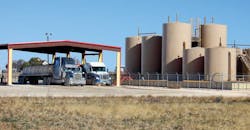US oilfield operators skeptical about the outlook for 2019
WHEN it comes to predicting US oilfield activity through 2019, there is a lot of uncertainty right now.
The general consensus seems to be that the Permian Basin will continue to drive US crude oil production, but lower wellhead prices are contributing to slower growth in Permian crude oil production in 2019 compared with 2018, according to the US Energy Information Administration. In addition, pipeline capacity limitations and other transportation capacity constraints are having an impact.
With major contributions from the Permian Basin and North Dakota’s Bakken region, US crude oil production averaged 10.9 million barrels per day. EIA has forecast more than 12 million barrels per day in 2019.
The Permian Basin could be an even bigger contributor to total annual US crude oil production, according to a recent report by the US Geological Survey. The report shows even more promise for the region. The agency estimates more than 46 billion barrels of oil and roughly 280 trillion cubic feet of natural gas are within two formations on the southwestern side of the basin. That would be potentially the largest continuous oil and gas resource ever surveyed.
Unconventional opportunities
Recent reports indicate that other regions with unconventional crude oil and natural gas reserves also could play a larger role in future crude oil production increases. One of these regions is the Greater Anadarko Basin in Texas, Oklahoma, and Kansas.
The basin reportedly holds an estimated 16 billion barrels of oil and more than 200 trillion cubic feet of natural gas in un-risked technically recoverable resources in unconventional reservoirs. The Anadarko reportedly has 41 stacked plays, which overlap in many parts of the basin. That means operators can access multiple targets from one well pad.
“The Anadarko Basin has long been a major contributor to US production, but it is just getting started in terms of delivering on its unconventional production potential,” said John Roberts, executive director, global subsurface operations and co-author of the IHIS Markit Anadarko Basin research with Prithiraj Chunkham, director of unconventional resources. “We are now witnessing a new kind of Oklahoma land rush.”
Roberts adds that only about 20% of the Anadarko’s STACK “sweet-spot” locations have been drilled or developed. “The play is still in its early stages of unconventional development,” he says. “We can easily envision an additional 4,000 to 5,000 horizontal wells drilled.”
The most recent Gulf Energy Outlook published by Louisiana State University’s Center for Energy Studies and the E J Ourso College of Business states that the unconventional shale plays show no sign of slowing down. The report states that it is simply too early in the unconventional revolution to discount the ingenuity of US producers and their ability to extract copious levels of hydrocarbons from these reserves.
Recent estimates emphasize that the Permian region is quickly running out of spare crude oil transportation capacity, particularly pipeline. Some reports have the region’s crude oil transportation pipeline capacity utilization as high as 96%, according to the Gulf Energy Outlook.
Pipeline capacity
These pipeline capacity constraints are real and have the potential to slow the region’s (and the United States’) ability to meet the anticipated global production shortfalls that could arise from the geo-political situations in Iran and Venezuela. In fact, pipeline constraints have been associated with price differentials of more than $20/barrel during the peak of the shale boom.
Pipelines are the principal concern, but shortages of crude oil tank trucks also have been noted. More pipeline capacity is set to come online in the Permian Basin in late 2019 and into 2020. If there are any delays in the Permian Basin pipeline projects, crude production growth could slow to a crawl in 2019, according to some analysts.
Service companies
With the amount of uncertainty for drilling and production in 2019, oilfield service companies are struggling. They have been hit with forced efficiencies, reduced day rates, and diminished backlogs.
Oilfield service companies are projected to grow just 9% in 2019. The service company outlook for this year dropped 64 points to -17.2.
While oilfield service companies are doing better in the Permian Basin than in other regions, they see a tough year ahead. Reportedly, about 20% of the frack fleet in the Permian Basin is currently idle, and many frack workers have left the region.
More wells are being drilled—but not completed—in the Permian Basin. That trend seems certain to continue.
Water haulers have reported difficulties finding enough drivers. Millions of barrels of water go into drilling each crude oil or gas well. All of that water must be hauled to the well site and then hauled away after the well is completed.

